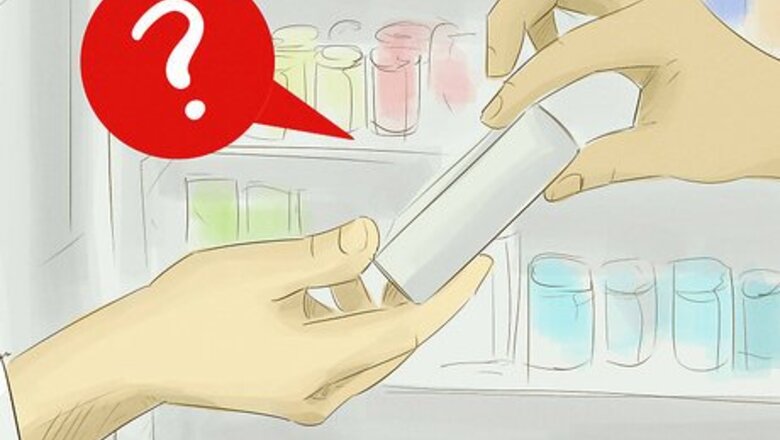
views
- If you have a small cut or wound, you can pour or dab a small amount of povidone-iodine onto the area to cleanse and disinfect it.
- Create a diluted solution of 1 part povidone to 10 parts distilled or boiled water to create a disinfectant you can use to flush mucus membranes like your mouth or genitals.
- If you're going to have an optical procedure, you can help prevent infections like conjunctivitis by placing 1 drop of 5% povidone solution eye drops into your eye beforehand.
Applying Povidone to the Skin

Read the label and any accompanying instructions. Depending on your circumstances, your doctor may have proscribed a large or small amount of povidone for treatment. This information will be included on the label and in the instructions, along with negative interactions, frequency of use, and special notes. Depending on the kind of povidone proscribed, the procedure for applying it may vary slightly. Povidone commonly comes in aerosol sprays, liquid solutions, creams, and saturated pads/swabs.

Clean the affected area with a mild soap. If the area where you’ll be applying the povidone is difficult to rinse in a sink, sponge bathe the area. All visible dirt should be removed from the area before applying the povidone. Dry the area with a clean towel afterwards.
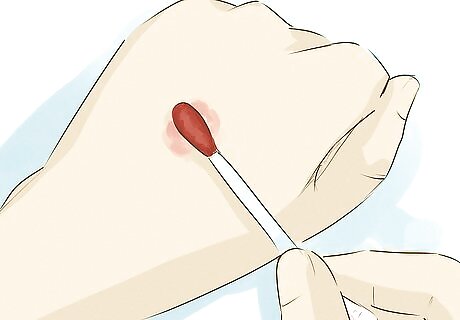
Apply a small amount of povidone to clean the affected area. In most situations, a small amount of povidone will be more than enough to cover the area. Depending on the size of the affected area and the instructions you're given, pour the solution, or use a dropper or cotton ball or swab. According to your preference, you can leave the area uncovered or cover it with a sterile bandage. Povidone solutions have a tendency to stain the skin a yellow-orange color. Even if a bandage isn’t necessary, it can be useful for hiding povidone stains.

Keep an eye out for allergic reactions. The most common side effect of using povidone is minor skin irritation. If this irritation persists for an extended period of time or worsens in severity, speak with your doctor. If you have any severe allergic reactions, like rashes, hives, itching, or swelling, see a doctor immediately. Povidone allergies are somewhat rare, but not unheard of. Take a moment to look at the allergy symptoms listed on label or in the instructions. Povidone should be stored at room temperature, away from light, heat, and moisture.
Diluting Povidone for Mucus Membranes

Boil some water. However, if you have some distilled water on hand, you can use that instead. Tap water should be brought to a rolling boil and left boiling for about 10 minutes. After that, remove the water from the heat and allow it to cool.
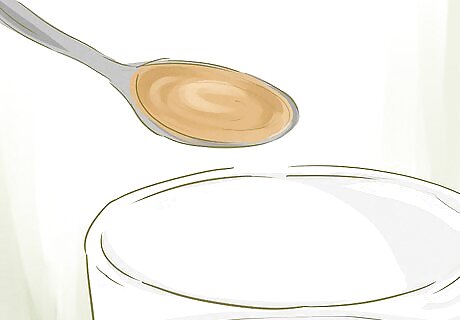
Mix the boiled water and povidone. You’ll want the ratio to be one part povidone for every ten parts distilled or boiled water. When the water cools to lukewarm, mix the povidone and the water together in a clean container. If your povidone came with an eyedropper, each drop will contain about 0.05 milliliters (0.0017 fl oz), or 20 drops per milliliter. To make 11 milliliters (0.37 fl oz) of diluted solution, mix 1 milliliter (0.034 fl oz) (20 drops) of povidone with 10 milliliters (0.34 fl oz) of distilled or boiled water.
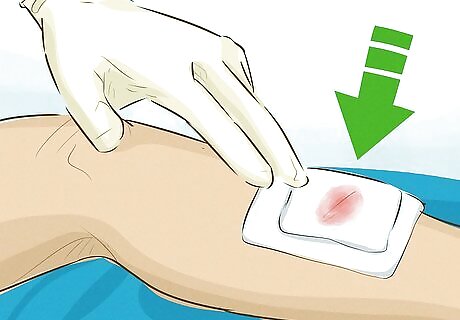
Flush affected areas with a small amount of diluted povidone. You may be able to pour your diluted solution right onto the affected area a little at a time, or you may need to use an eyedropper to apply it. Use no more than 10 milliliters (0.34 fl oz) of the solution for 30 seconds per application. You can flush an affected area with a diluted povidone solution in this fashion up to four times a day for a max of 14 days in a row. If using diluted povidone vaginally, only apply a diluted solution once per day for 14 days at most (including days you are menstruating). When using povidone to treat the mouth or throat, avoid swallowing the diluted solution. Treating the mouth or throat with povidone isn’t recommended for children under six years old.
Using Povidone Eye Drops

Wash your hands. Wet your hands with water from a sink faucet and thoroughly lather your hands with soap. Remember to scrub the areas between your fingers, under your nails, and around your wrists. After roughly 20 seconds of scrubbing, rinse your hands with water. The kind of soap you use is up to your personal preference. Any normal kind of hand soap should work just fine. Hand sanitizer might be your best bet for cleaning your hands if there isn’t a convenient source of clean water in your area.

Inspect the dropper for dirtiness or damage. Your dropper should not be cracked, chipped, or otherwise deformed. A deformed dripper can cause you to apply too much medicine, which can result in irritation or overdose. Refrain from touching the dropper with your hands or touching the dropper to any surface. This can dirty the dropper and contaminate the solution.

Tip your head back and pull down your lower eyelid. Use your index finger to pull lightly down on your lower eyelid. This will form a small pocket between your eyeball and the skin around it. With your free hand, position the dropper over your eye. The dropper should be very close to your eye, as this will reduce missed drops and wasted medicine. However, be careful not to touch the dropper to your eye.

Squeeze out a single drop per eye. Medicinal eye drops should be applied one drop at a time to prevent over application. Squeeze the dropper so it emits a single drop that falls into the pocket formed by your pulled down eyelid and eyeball. It can help to look upwards when applying eyedrops. If your hands are unsteady, brace your fingers against your face. Using a 5% povidone solution is common before optical surgery or procedures, as it reduces your chances of contracting conjunctivitis (pinkeye).

Wipe away excess fluid and reapply more drops as necessary. Release your lower lid by removing your index finger from it. Close your eyes for roughly two minutes and roll them around to distribute the solution throughout your eyes. Any remaining fluid can be wiped away with a tissue. Some doctors may direct you to use more or less drops depending on your situation. Additional drops should be applied in the same fashion as the first. If you have to use multiple drops in a single eye, generally you should wait about five minutes between drops.
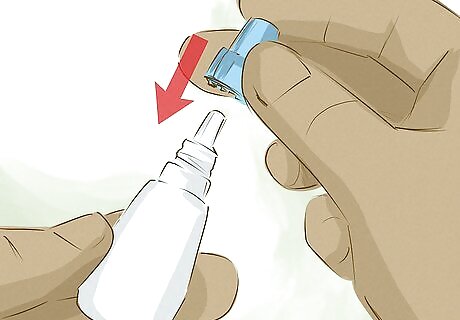
Put away your eyedrops and wash your hands. Return the lid to the dropper without wiping or rinsing it. Put the eyedrops away and then wash your hands one more time. The final handwashing is necessary to remove solution that may have spread to your fingers while applying the drops. Store your povidone at room temperature in a location that keeps the solution from exposure to light, heat, and moisture.




















Comments
0 comment